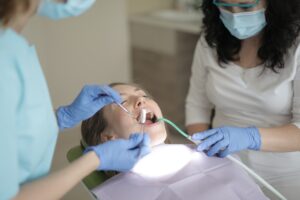 Dental sedation is a great option to ensure a child receives the care they need while keeping them comfortable. Although you want them to achieve their best smile, it’s normal to have concerns about the safety of dental sedation for children. There’s no reason to worry. There are strict guidelines for pediatric dental sedation to ensure your little one’s safety. Here’s what you need to know to make the best decision for your child’s dental health.
Dental sedation is a great option to ensure a child receives the care they need while keeping them comfortable. Although you want them to achieve their best smile, it’s normal to have concerns about the safety of dental sedation for children. There’s no reason to worry. There are strict guidelines for pediatric dental sedation to ensure your little one’s safety. Here’s what you need to know to make the best decision for your child’s dental health.
Guidelines for Pediatric Dental Sedation
Dental-related fears and phobias can affect anyone, including children. Dental sedation can calm their anxiety to keep them comfortable while in the dentist’s chair. However, sedation dentistry can also be suitable for children with special needs or requiring invasive procedures. Their pediatric dentist will keep their safety their top priority.
In 2019, the American Academy of Pediatrics updated the guidelines on sedation for children, which requires at least 2 people in the room to be trained in advanced life-support measures as a precaution. There must also be an independent observer in the room. Your child will be closely monitored to detect anything concerning promptly. Depending on the type of sedation, their vitals will be monitored for their safety.
Types of Dental Sedation
Your child’s dentist will learn more about their health history and any prescribed or over-the-counter medications they’re taking to ensure they are a candidate for dental sedation. Based on your child’s needs and situation, their dentist will recommend:
- Nitrous Oxide: More commonly called “laughing gas,” nitrous oxide is an inhaled sedative that’s safe for patients of all ages, including children. Masking is placed over your child’s nose to deliver the sedative. It takes effect quickly and wears off just as fast.
- Local Anesthesia: A local anesthetic can also be used to block pain during dental procedures. It will make your child’s mouth numb, so they won’t feel any pain. It can be used along with nitrous oxide and other sedatives.
- Hospital Dentistry: Patients with significant oral health issues or situations that require a specialized setting can’t benefit from hospital dentistry. A qualified anesthesiologist will be with your child at all times for their safety.
Choosing dental sedation for your child is a big decision. Their pediatric dentist will explain everything and address any concerns to help you make the most educated decision for your child’s safety and oral health needs.
About Dr. Marie Tremblay
Dr. Tremblay has over 20 years of experience in pediatric dentistry. She earned her dental degree at the University of Montreal and continued her education in pediatric dentistry. She provides complete care for children, including sedation dentistry. She is a proud member of the American Board of Pediatric Dentistry and the American Academy of Pediatric Dentistry. Request an appointment through her website or contact her office.
